SANG-KYU JOO • GABRIEL GAROFALO • NOAH ANTONI RYZEWICZ • MATTHEW CHETCUTI
• TANYA SVITAK
• YAN GAO • JULIA DI GIORGIO • SOFIA CERASUOLO
Interweave
Making Support Services Joyful + Engaging
![]()
![]()
Interweave
Making Support Services Joyful + Engaging

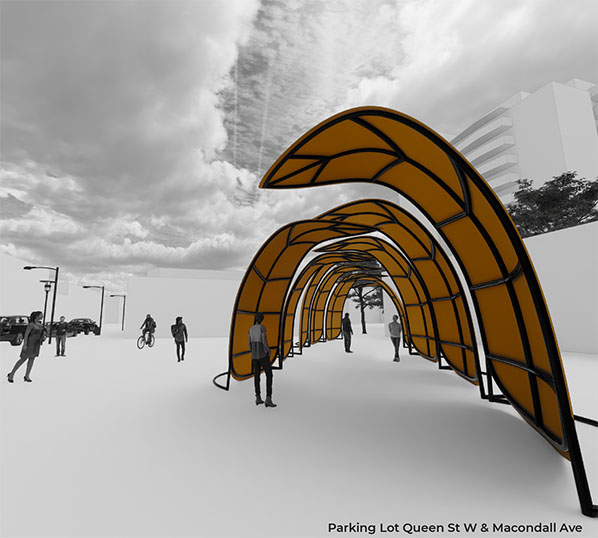
Themes
- Community
- Social Spaces / Infrastructure
- Support Spaces
- Affordability of Living
- Identity of Neighbourhood
- Visibility of Services
Design Principles
- Vibrant
- Light weight
- Mobile
- Accessible
- Recognizable
- Multi-use
- Community
- Social Spaces / Infrastructure
- Support Spaces
- Affordability of Living
- Identity of Neighbourhood
- Visibility of Services
Design Principles
- Vibrant
- Light weight
- Mobile
- Accessible
- Recognizable
- Multi-use
Thesis
How might we create community growth and social interaction through informal spaces which allow for social and economic infrastructure to be generated?
How might we provide a space for seniors that combines safety, community and emotional/financial well-being in an easily accessible manner?
How might we reintegrate homeless youth of marginalized
groups within the community, while encouraging leadership,
and financial safety?
How might we promote and provide services to insure comfort
and well being of new immigrants in the community?
How might we create community growth and social interaction through informal spaces which allow for social and economic infrastructure to be generated?
How might we provide a space for seniors that combines safety, community and emotional/financial well-being in an easily accessible manner?
How might we reintegrate homeless youth of marginalized
groups within the community, while encouraging leadership,
and financial safety?
How might we promote and provide services to insure comfort
and well being of new immigrants in the community?
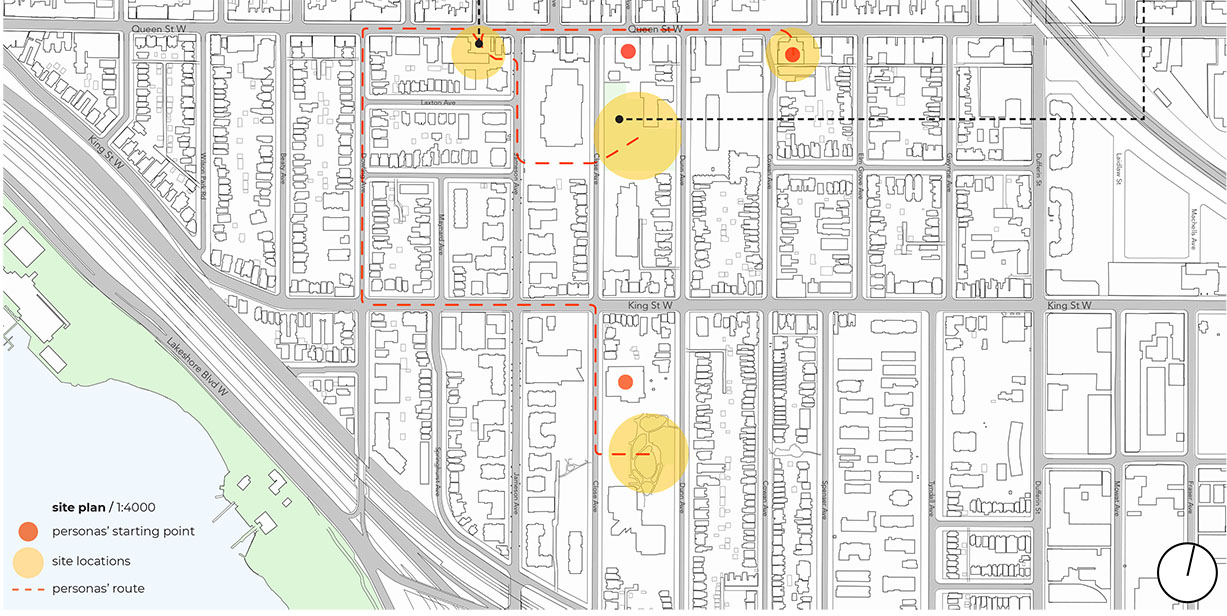
The petals of a flower and the leaves of a fruit tree serve many purposes. These curved element of nature absorb energy and nutrients to help their fruit flourish. The flower petal also protects the pollen within from various disturbances in its environment. The vibrant colours of flower petals attract pollinators encouraging the spread of nutrients within their ecosystems. Borrowing from this phenomenon as a form of biomimicry, we were inspired to carry these principles into a design language.
Through working with various personas of Toronto’s Parkdale
Neighbourhood, we came to conclude that there are a wide range of cultures, demographics and forms of life. However, each of these groups appear to have similar aspirations for their neighbourhood. Similar to a flowers symbiotic relationship with bees, butterflies and hummingbirds, each of which have crucial roles in their shared environment. By creating a system, program and informal structures, we are intending to insight the symbiotic relationships that potentially preside in Parkdale.
Our design concept consists of modular curved panels that can be arranged to create informal shaded social spaces. These panels can for large and small canopy spaces throughout central Parkdale. Their vibrant colour and memorable form are aimed to attract and invite the community to gather.
By targeting groups of need such as seniors living alone, new immigrants within the community and low-income youth of minority groups we strive to bring them together to create an interweaving of culture, age and abilities. This relationship aided by the design we propose can strengthen and form social resilience in the Parkdale neighbourhood for years to come.
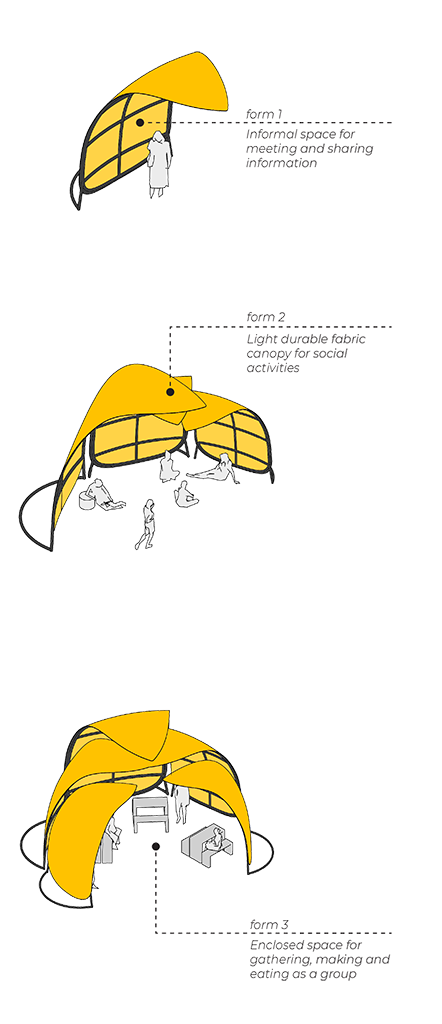

Amala is a senior citizen that resides in the Lakeside Long Term Care Centre
on Dunn Ave in Parkdale. She lives alone and does what she can to feel independent. She is strong minded and follows values rooted in her Tibetan heritage. She is very talented at knitting and weaving as she once worked at a carpet weaver when she was young. She still finds time to work her hands and sew. Amala’s time spent alone causes her to feel lonely and isolated. She strives to get out into the community more and talk to people about her story and feel like she is needed.
Ever so often Amala walks around the nearby park just outside the Long Term Care Centre. As she approaches the park she sees large canopy structures filled with young and old members of the community. A young volunteer asks her to join the other in social events and crafting activities. Amala is excited and is then told her work will be on display at the market on queen street.

Daniel comes from a low-incomefamily and has a troubled relationship
due to his identity for being part of the LGBTQ2+ community. Due to his conflictwith his family, Daniel has been kicked out of his home. He has been on a journey of searching for a place he can reside in repetitively and wants to one daylive independently. However, the neglect from his parents due to his identity hascreated doubt about him. He became more and more hesitant overtime to expose himself to ask for help in-person. After the day in school, Daniel plans to visitParkdale Public Library on Queen Street to use a computer to see what he cando or receive support that would make his desire into reality as a stepping stone.
As Daniel visited the public library, helearned that the facility also functions as
a community information center of the Parkdale. While he was not interested andlooked to see if a computer was available in the building, he was greeted by the volunteer to answer if he was interested in joining the current community activity. Danielwas persuaded by being able to use the experience in his work resume and howhe may have the opportunity to meet new people, even perhaps those who identify as part of LGBTQ2+. Daniel decided to join the activity to see if he can learn theirstories and become friends with them.
due to his identity for being part of the LGBTQ2+ community. Due to his conflictwith his family, Daniel has been kicked out of his home. He has been on a journey of searching for a place he can reside in repetitively and wants to one daylive independently. However, the neglect from his parents due to his identity hascreated doubt about him. He became more and more hesitant overtime to expose himself to ask for help in-person. After the day in school, Daniel plans to visitParkdale Public Library on Queen Street to use a computer to see what he cando or receive support that would make his desire into reality as a stepping stone.
As Daniel visited the public library, helearned that the facility also functions as
a community information center of the Parkdale. While he was not interested andlooked to see if a computer was available in the building, he was greeted by the volunteer to answer if he was interested in joining the current community activity. Danielwas persuaded by being able to use the experience in his work resume and howhe may have the opportunity to meet new people, even perhaps those who identify as part of LGBTQ2+. Daniel decided to join the activity to see if he can learn theirstories and become friends with them.

Raj has recently moved into a unit inan apartment’s basement in South Park-
dale, Toronto. Finding a place to settle in a foreign country with a language he didnot fully understand was challenging. Raj soon understands the dire situation afterovercoming the challenge of moving in, that he needs to learn English as soon aspossible. But who can he rely on to ask such a question? He is determined to continue to live in Canada but is new to this community. As thinking of a solution alone in his new home would not resolve anything, Raj decides to take a walk aroundin the neighborhood to get some fresh air.
As Raj walks down on Close Avenue,he hears a bustling noise from afar. His
curiosity to better understand his neighborhood guided him to the source of thesound. As Raj gets close to the place, he sees groups of lively people gathering infront of interestingly shaped stands. He introduced himself with broken Englishand was greeted with a warm welcome. Despite the trouble, Raj understood thatcommunity centers are hosting a community sharing pavilion in Parkdale forsocial exchange and to gain work experience in Canada. He takes this opportunity to see if he can create a social network in this community and searchfor anyone with the same background.
dale, Toronto. Finding a place to settle in a foreign country with a language he didnot fully understand was challenging. Raj soon understands the dire situation afterovercoming the challenge of moving in, that he needs to learn English as soon aspossible. But who can he rely on to ask such a question? He is determined to continue to live in Canada but is new to this community. As thinking of a solution alone in his new home would not resolve anything, Raj decides to take a walk aroundin the neighborhood to get some fresh air.
As Raj walks down on Close Avenue,he hears a bustling noise from afar. His
curiosity to better understand his neighborhood guided him to the source of thesound. As Raj gets close to the place, he sees groups of lively people gathering infront of interestingly shaped stands. He introduced himself with broken Englishand was greeted with a warm welcome. Despite the trouble, Raj understood thatcommunity centers are hosting a community sharing pavilion in Parkdale forsocial exchange and to gain work experience in Canada. He takes this opportunity to see if he can create a social network in this community and searchfor anyone with the same background.




Raj, Daniel, and Amala, as well as other volunteers and visitors, all meet at the parking lot near the intersection of Macdonell
Avenue and Queen Street West, where the community activity is taking place in the pavilion. While Daniel is supporting the media team to spread awareness of the event in Parkdale that the community can freely visit, Raj and Amala began creating arts and crafts with the supplies provided. Despite the language barrier, Raj was comfortable
working with Amala as he has experience helping seniors thanks to his background. Amala praised his support and gave bits of advice from her experiences in living in Parkdale and Canada. As time passed, they began to feel connected to each other about something they both lacked.
working with Amala as he has experience helping seniors thanks to his background. Amala praised his support and gave bits of advice from her experiences in living in Parkdale and Canada. As time passed, they began to feel connected to each other about something they both lacked.
As the pavilion opens, Amala and Raj are joined by Daniel, which his work in the media team has finished. Although they are not in the same age group or the minority group, Amala and Raj welcomed him and his identity. They shared more stories and talked about each other, even with the customers while doing business, which allowed the people of the community to learn about them.
As the people of Parkdale visited the community sharing pavilion, the business went well. Raj, Daniel, and Amala found the experience to be profound, something that would not have been possible if they were
to do it alone. Voluntary activity has allowed them to introduce themselves to the community while being supportive of each other. Despite their differences in background, age, and circumstances, they learn that they can rely on Parkdale’s community for their physical and emotional well being.



After Amala experiences the social
gatherings she has made new friends and
feels the power of their support. Every week
she meets at the pod locations to talk to
the younger generation and work with
her hands. She now feels a new sense of
purpose, as her stories are inspiring to the
young and her craftwork is appreciated by
the community. When walking around the
community Amala calls on Raj to help her,
he uses his healthcare background to walk
with her safely. She no longer feels isolated
and is now aware of the programs the community has in place. Daniel brings Amala to
the new tech hub at the Public Library to
help her contact her younger family living
in China. She enjoys telling Daniel about
her youth and her early years in Canada.
Daniels’ self confidence thrives as heis seen as a valued volunteer within hiscommunity. The impact of working with
other members of the community thathave struggled in some form or anotherhas taught him new values. Hearing Ama
la and Raj’s stories of restarting life with
nothing, resides with him. His positionas a minority within the community hasbecome much less of an isolating factor. His love of technology has been spreadto younger and older generations as wellas the new members of Parkdale. Daniel builds his resume and connections withgoals of landing a decent job. A local shopowner hires Daniel to manage their online marketplace and social media platform.
nothing, resides with him. His positionas a minority within the community hasbecome much less of an isolating factor. His love of technology has been spreadto younger and older generations as wellas the new members of Parkdale. Daniel builds his resume and connections withgoals of landing a decent job. A local shopowner hires Daniel to manage their online marketplace and social media platform.
Raj returns to the market frequently as he can, as he now works at a nearbynursing home as an attendant. He gained
this employment after volunteering andsharing his story at the market. An employee from the nursing home who also volunteers heard about his past experience withhealthcare in his previous country. Amala’sstory had a real impact on his life, as henow knows he is not alone in the strug-
gles of immigration in Parkdale. Raj talkswith Daniel often, as they chat about howto use online resources and websites that may help Raj stay connected and up to datewith the community and living in Canada.
gles of immigration in Parkdale. Raj talkswith Daniel often, as they chat about howto use online resources and websites that may help Raj stay connected and up to datewith the community and living in Canada.
Parkdale Market
![]()
![]()
![]()


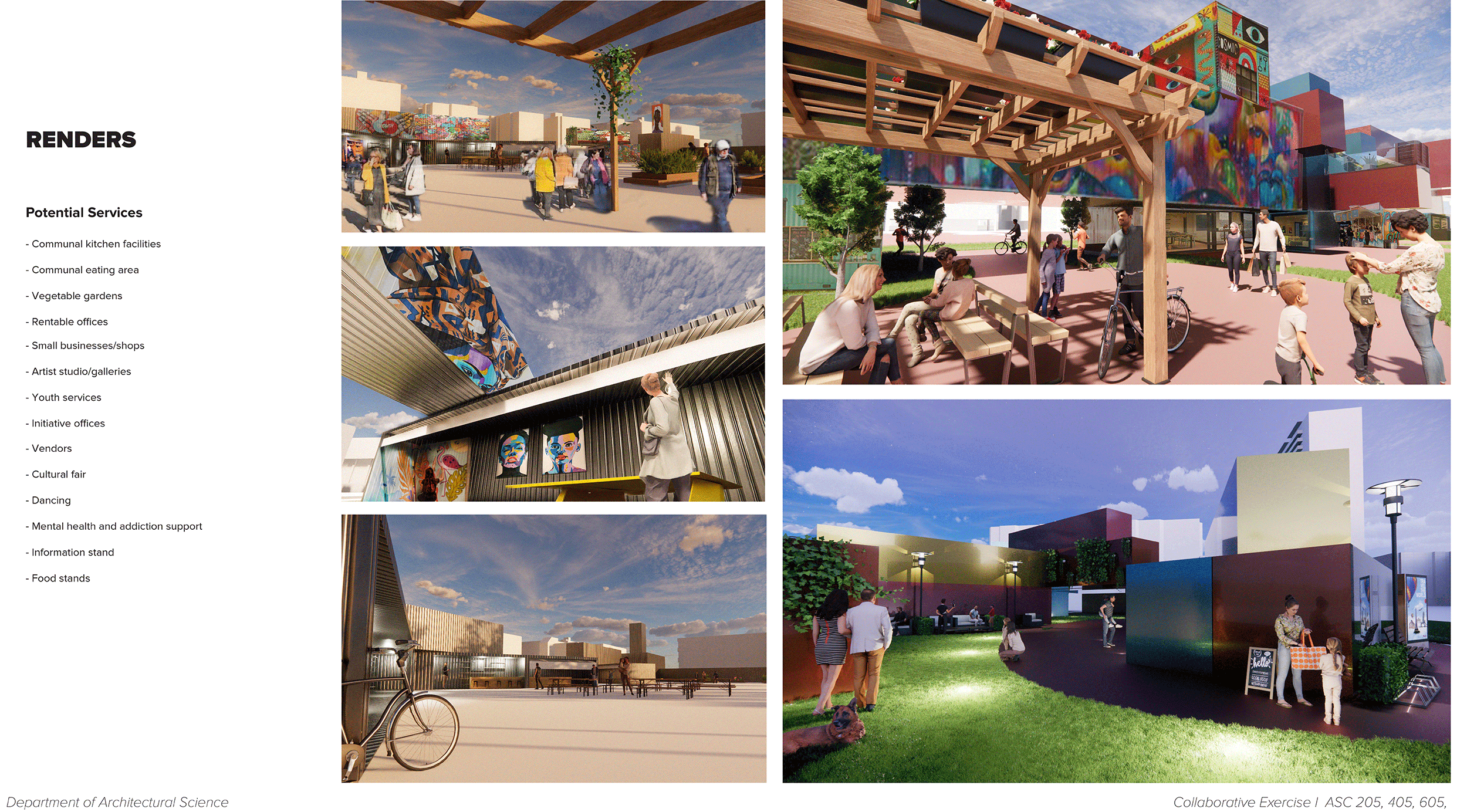
ANNA YABLOCHNIKOVA • ERIC BOWEN • ERIN HOI LAM PANG • GURNOOR KAINTH • KATERYNA STOKOZ • LEE YING NATLIE CHAN • MELISSA CAETANO FAVAS • PRITHTHI ANTHONY ASCENSION • SUWATHY VIVEKANANTHAN
COWANTEGRATION
Making Support Services Joyful + Engaging
![]()
![]()
COWANTEGRATION
Making Support Services Joyful + Engaging


PROJECT SUMMARY:
Within this development of Cowan Avenue, our intent was to bridge the gap between the old residents of the community with the new
residents. This was to create a more inclusive community that could rely on all the residents without judgement of age, race, life experience or status. We did this by creating spaces along Cowan Avenue that presented spaces for both the populous to converse and spark dialogue while working with one another to benefit the community. The development strives to create a seamless integration by redeveloping an existing building at the heart of the residential area and converting it into a community hub that can house all sorts of activities and information boards along the street to inform residents that they are not alone in their struggles. In conclusion, this redevelopment of Cowan Avenue is one that benefits all members of the community and creates a welcoming environment.
Within this development of Cowan Avenue, our intent was to bridge the gap between the old residents of the community with the new
residents. This was to create a more inclusive community that could rely on all the residents without judgement of age, race, life experience or status. We did this by creating spaces along Cowan Avenue that presented spaces for both the populous to converse and spark dialogue while working with one another to benefit the community. The development strives to create a seamless integration by redeveloping an existing building at the heart of the residential area and converting it into a community hub that can house all sorts of activities and information boards along the street to inform residents that they are not alone in their struggles. In conclusion, this redevelopment of Cowan Avenue is one that benefits all members of the community and creates a welcoming environment.







HOW MIGHT WE...
Create opportunities for the isolated residents to find resourceful
connections, and gain skills?
Create inclusive communal spaces which will encourage the sharing
of cultures, experiences, and needs between the new incoming
immigrants and current residents of the community?



The mornings tend to be extremely hectic for Maya as she has to wake her mother with some medication, prepare breakfast, and school lunches for her son Ethan. Soon after with Ethan in hand, she rushes to the nearby school, Holy Family Catholic School. She often feels overwhelmed, as if she’s stuck in this repetitive cycle of rushing everywhere. Between dropping off Ethan and beginning her workshift she has a couple minutes to herself, yet everything is closed. Maya wants to get a book, but the library has not opened yet. Maya wants to chat with a couple friends, but the community
centre isn’t opened yet. She feels so disconnected.
Luckily, she finds a sense of home at her momo shop, which is located on Queen Street West. Although business has been pretty slow, all her childhood memories spent in the restaurant compel Maya to keep the family business operating. Slowly losing her mother to Alzheimer has been difficult for Maya. Her mother is her best friend, her rock, her support system, but now its as if they are living two seperate lives. The only reminder of their close relationship they once had are the Tibetan paintings hanging in the momo shop.
Due to gentrification of Parkdale and the raise of rent, Maya lives in constant fear of losing her shop. It has become impossible to provide for her son, her mother and keep a business as a single mother. She works long hours, and this impacts her ability to spend quality time with the people sheloves. Maya is unable to pick up Ethan from school. Maya is unable to help her mother at home. She feels so disconnected.
The only opportunity for Maya to connect with her family and the community is by donating the left-over food from her restaurant to the homeless folks on her way home.The morning is Maya’s favourite time of day. On her route to work, Maya brings along her son, Ethan and her mother, Yuma. Together they discuss events from previous day, their worries, their goalsfor the day, this walk has become a significant connection in their relationship. After Ethan goes to school, the mother and daughter duo make their way down Cowan Ave. The street is welcoming, they continue their daily ritual of picking up a book at the candy cane information hub. Due toYama’s condition, she enjoys reading books about the Tibetan culture as it assists her in gainingmemory about her life. They walk down Cowan avenue towards COWANTEGRATION. Maya remembers passing the houses before, they were a negative statement to the neighborhood. There wouldalways be addicts and alcoholics, but now the centre has become the complete opposite. The seniors meetings which take place, the gardening, and painting which that space provides has become an escape from the constraint of her apartment for her mother. The stained glass, and the outdoorgarden inspires Yuma to paint the most beautiful paintings. Now walking alone, further down thestreet Maya passes an information bulletin, where she finally pins an employment opportunity ather restaurant.
Once again, Maya has a few minutes before work and because of the new intervention she has the possibility to join her friends at the social hub at the Queen Street West and Cowan avenue intersection. She is connected to the community.
Maya’s business, Little Tibet, is growing everyday. Due to the intervention, there are multiple residents interacting with her momo shop. Inside the shop, there are both new and old residents interacting, it has become another communal space. Consequently, she has become much more financially stable and has been able to provide for her mother and son. She is no longer considering to sell her family restaurant. Maya is more stable financially and socially.
Luckily, she finds a sense of home at her momo shop, which is located on Queen Street West. Although business has been pretty slow, all her childhood memories spent in the restaurant compel Maya to keep the family business operating. Slowly losing her mother to Alzheimer has been difficult for Maya. Her mother is her best friend, her rock, her support system, but now its as if they are living two seperate lives. The only reminder of their close relationship they once had are the Tibetan paintings hanging in the momo shop.
Due to gentrification of Parkdale and the raise of rent, Maya lives in constant fear of losing her shop. It has become impossible to provide for her son, her mother and keep a business as a single mother. She works long hours, and this impacts her ability to spend quality time with the people sheloves. Maya is unable to pick up Ethan from school. Maya is unable to help her mother at home. She feels so disconnected.
The only opportunity for Maya to connect with her family and the community is by donating the left-over food from her restaurant to the homeless folks on her way home.The morning is Maya’s favourite time of day. On her route to work, Maya brings along her son, Ethan and her mother, Yuma. Together they discuss events from previous day, their worries, their goalsfor the day, this walk has become a significant connection in their relationship. After Ethan goes to school, the mother and daughter duo make their way down Cowan Ave. The street is welcoming, they continue their daily ritual of picking up a book at the candy cane information hub. Due toYama’s condition, she enjoys reading books about the Tibetan culture as it assists her in gainingmemory about her life. They walk down Cowan avenue towards COWANTEGRATION. Maya remembers passing the houses before, they were a negative statement to the neighborhood. There wouldalways be addicts and alcoholics, but now the centre has become the complete opposite. The seniors meetings which take place, the gardening, and painting which that space provides has become an escape from the constraint of her apartment for her mother. The stained glass, and the outdoorgarden inspires Yuma to paint the most beautiful paintings. Now walking alone, further down thestreet Maya passes an information bulletin, where she finally pins an employment opportunity ather restaurant.
Once again, Maya has a few minutes before work and because of the new intervention she has the possibility to join her friends at the social hub at the Queen Street West and Cowan avenue intersection. She is connected to the community.
Maya’s business, Little Tibet, is growing everyday. Due to the intervention, there are multiple residents interacting with her momo shop. Inside the shop, there are both new and old residents interacting, it has become another communal space. Consequently, she has become much more financially stable and has been able to provide for her mother and son. She is no longer considering to sell her family restaurant. Maya is more stable financially and socially.
After taking a couple wrong turns post graduating from university, Diego has decided to move and
restart his life at Parkdale. He is new to the area, so as a way to start the day, Diego has picked up
the hobby of morning runs around the neighbourhood streets. This way, he hopes to familiarize
himself with the location and meet some new people. Diego begins to slowly settle into the area
with the hopes of starting a business venture, although at the moment such a task seems very far-fetched and intangible.
Diego tries to keep himself occupied so that the thought of being unemployed doesn’t get the best of him. As a result he finds himself to enjoy cooking. During the week Diego would drop by the local grocery store, Queen Fresh Market to pick up some groceries to cook some of his favourite dishes. Diego is also a bookworm so he often drops by the Toronto Public Library. Back home, he would participate in book exchange programs but after moving he hasn’t found any book exchange programs nearby.
After having his lunch, Diego goes to the library almost everyday to do some reading and look for employment opportunities nearby. Following many hours each day spent at the library, he heads home feeling hopeless. Diego feels burnt out and disconnected.Diego learns about the community hub COWANTEGRATION after discovering a community gather ing group. Diego sees this as an opportunity to meet other members of the community that could potentially aid him. He realizes that this would be beneficial towards familiarizing himself with his neighbours. Diego finds the location of the hub to be very convenient as it is located directly behind his home.
On his walk to the community hub for the first time, Diego is astonished to see a brightly lit and colourful alleyway leading towards his destination. He recalls crossing through this alleyway before but he remembered it being so dark and empty. Walking down this user friendly passage now puts Diego in an optimistic mood even before reaching the hub. He takes a minute to pause and admire the interaction between individuals in the community garden situated behind the community hub. He hears giggles as children run around and sees adults and the elderly conversing with each other while enjoying the beauty of the garden.
Soon after the development of the hub, Diego learns that his realization was right, Through the community hub, Diego was able to find new opportunities that allowed him to finally gain a sense of belonging in the Parkdale neighbourhood. He was pleased by the fact that he could now access several resources in the community hub and in the book exchange boxes, that are both near his place of residence.
After meeting members of the community, Diego no longer feels like a stranger. This is his new home and these people are his community. He is connected to the community.
He quickly grows his network after becoming a regular visitor of the hub and finds a job as the manager of one of the storefront businesses within the hub.
In addition to working at the hub, his hobby as an artist provides him the opportunity to become a volunteer instructor and host art workshops as well as sell his cultural art to the community. Diego who was once a new face in the community has become a very popular and loved face and he is
proud of who he has become.
Diego tries to keep himself occupied so that the thought of being unemployed doesn’t get the best of him. As a result he finds himself to enjoy cooking. During the week Diego would drop by the local grocery store, Queen Fresh Market to pick up some groceries to cook some of his favourite dishes. Diego is also a bookworm so he often drops by the Toronto Public Library. Back home, he would participate in book exchange programs but after moving he hasn’t found any book exchange programs nearby.
After having his lunch, Diego goes to the library almost everyday to do some reading and look for employment opportunities nearby. Following many hours each day spent at the library, he heads home feeling hopeless. Diego feels burnt out and disconnected.Diego learns about the community hub COWANTEGRATION after discovering a community gather ing group. Diego sees this as an opportunity to meet other members of the community that could potentially aid him. He realizes that this would be beneficial towards familiarizing himself with his neighbours. Diego finds the location of the hub to be very convenient as it is located directly behind his home.
On his walk to the community hub for the first time, Diego is astonished to see a brightly lit and colourful alleyway leading towards his destination. He recalls crossing through this alleyway before but he remembered it being so dark and empty. Walking down this user friendly passage now puts Diego in an optimistic mood even before reaching the hub. He takes a minute to pause and admire the interaction between individuals in the community garden situated behind the community hub. He hears giggles as children run around and sees adults and the elderly conversing with each other while enjoying the beauty of the garden.
Soon after the development of the hub, Diego learns that his realization was right, Through the community hub, Diego was able to find new opportunities that allowed him to finally gain a sense of belonging in the Parkdale neighbourhood. He was pleased by the fact that he could now access several resources in the community hub and in the book exchange boxes, that are both near his place of residence.
After meeting members of the community, Diego no longer feels like a stranger. This is his new home and these people are his community. He is connected to the community.
He quickly grows his network after becoming a regular visitor of the hub and finds a job as the manager of one of the storefront businesses within the hub.
In addition to working at the hub, his hobby as an artist provides him the opportunity to become a volunteer instructor and host art workshops as well as sell his cultural art to the community. Diego who was once a new face in the community has become a very popular and loved face and he is
proud of who he has become.
Liam graduated from Western University studying literature.
He is financially stable because of his family’s background.
Recently moved into a house with his partner, Shawn, just north of
Queen St.
Although it has been a week since Liam and his partner Shawn have arrived at North Parkdale, still on some mornings Liam has difficulty defining his house as his home. On the way to work Liam passes by multiple people but cannot recognize a single face. The streets, the stores, the people are all unfamiliar.
Liam had previously studied the neighbourhood’s fascinating history, and as a result has inspired him to work at a nonprofit organization: Parkdale Project Reed. Every so often, Liam leaves for work earlier to get some lunch at a local shop on Queen Street West. The people that Liam encounters at work are very genuine, kind, and friendly but he finds himself lacking an emotional connection with them. It is almost as if he is an outsider unable to get past the gate.
Liam wants to feel as part of the Parkdale community, but there are limited resources that will allow him to do so. He is always searching for ways to give back, but doesn’t know where. He feels so disconnected.
It has been only a week since Liam and his partner Shawn have arrived North Parkdale. The immediate community feel is noticeable. In the mornings on his way to work, at Parkdale Project Reed, a nonprofit organization, he passses by repetitive streets, unfamiliar faces. It’s become a cycle, but this morning, a paved sidewalk catches his eye. There are lots of people gathering there, kids, adults, seniors.
As a consequence of a simple street, Liam has met a lot of his close friends. He consistently volunteers at COWANTEGRATION, and aids the residents with gardening, furthermore, he often joins the discussions which are held at that location. It’s become a ritual.
Liam’s no longer walks in the morning on repetitive streets with unfamiliar people. The streets are home, the people are family. He is part of a community.
Although it has been a week since Liam and his partner Shawn have arrived at North Parkdale, still on some mornings Liam has difficulty defining his house as his home. On the way to work Liam passes by multiple people but cannot recognize a single face. The streets, the stores, the people are all unfamiliar.
Liam had previously studied the neighbourhood’s fascinating history, and as a result has inspired him to work at a nonprofit organization: Parkdale Project Reed. Every so often, Liam leaves for work earlier to get some lunch at a local shop on Queen Street West. The people that Liam encounters at work are very genuine, kind, and friendly but he finds himself lacking an emotional connection with them. It is almost as if he is an outsider unable to get past the gate.
Liam wants to feel as part of the Parkdale community, but there are limited resources that will allow him to do so. He is always searching for ways to give back, but doesn’t know where. He feels so disconnected.
It has been only a week since Liam and his partner Shawn have arrived North Parkdale. The immediate community feel is noticeable. In the mornings on his way to work, at Parkdale Project Reed, a nonprofit organization, he passses by repetitive streets, unfamiliar faces. It’s become a cycle, but this morning, a paved sidewalk catches his eye. There are lots of people gathering there, kids, adults, seniors.
As a consequence of a simple street, Liam has met a lot of his close friends. He consistently volunteers at COWANTEGRATION, and aids the residents with gardening, furthermore, he often joins the discussions which are held at that location. It’s become a ritual.
Liam’s no longer walks in the morning on repetitive streets with unfamiliar people. The streets are home, the people are family. He is part of a community.



SIDEWALK SEATING:
These information centers encourage community members to share their cultures and experiences through its use of bulletin boards and interactive information boards that rest against the canopies.
The seating areas provide communal spaces where residents are invited to take advantage of the books located within most ofthe seats and enjoy these “little libraries”.



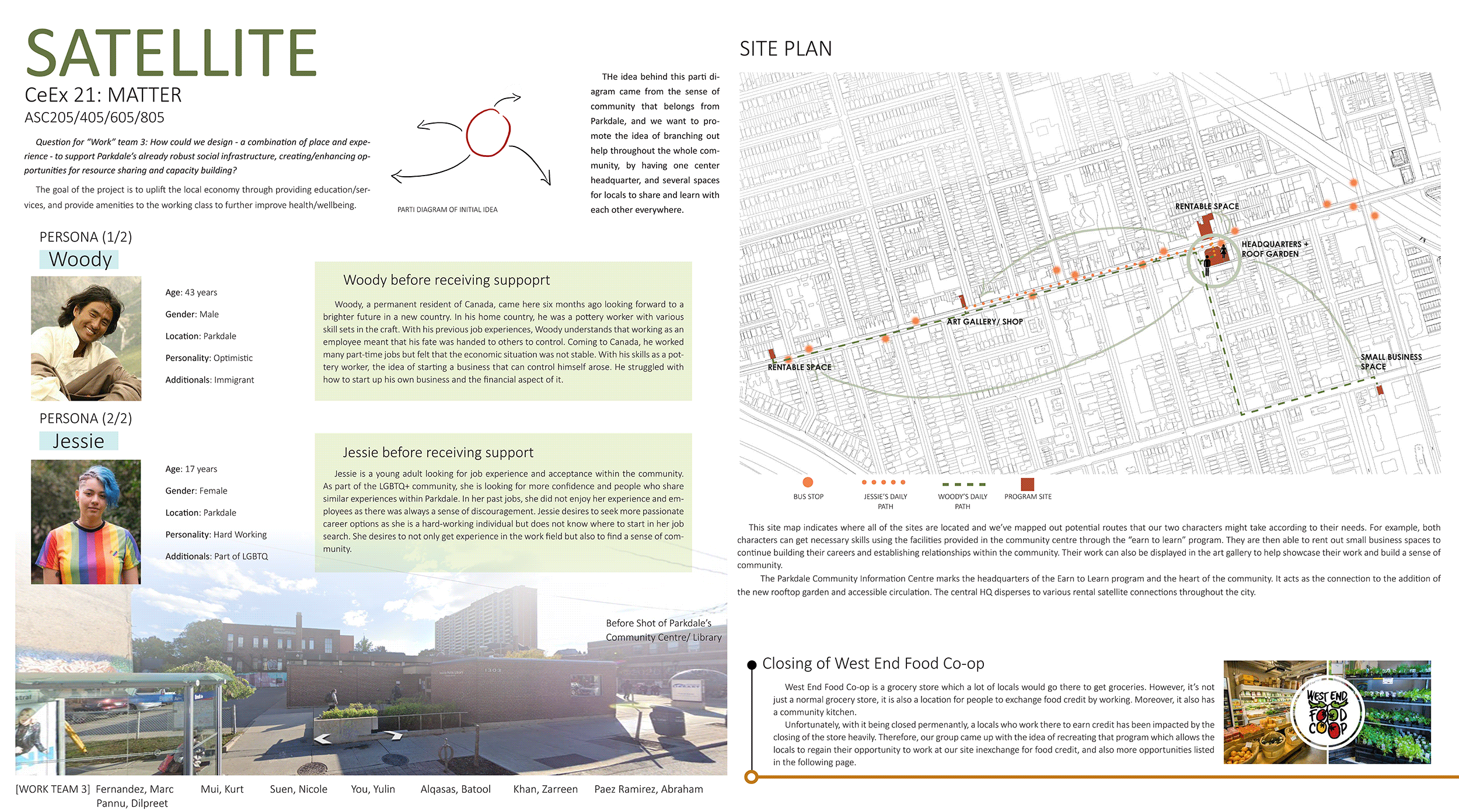
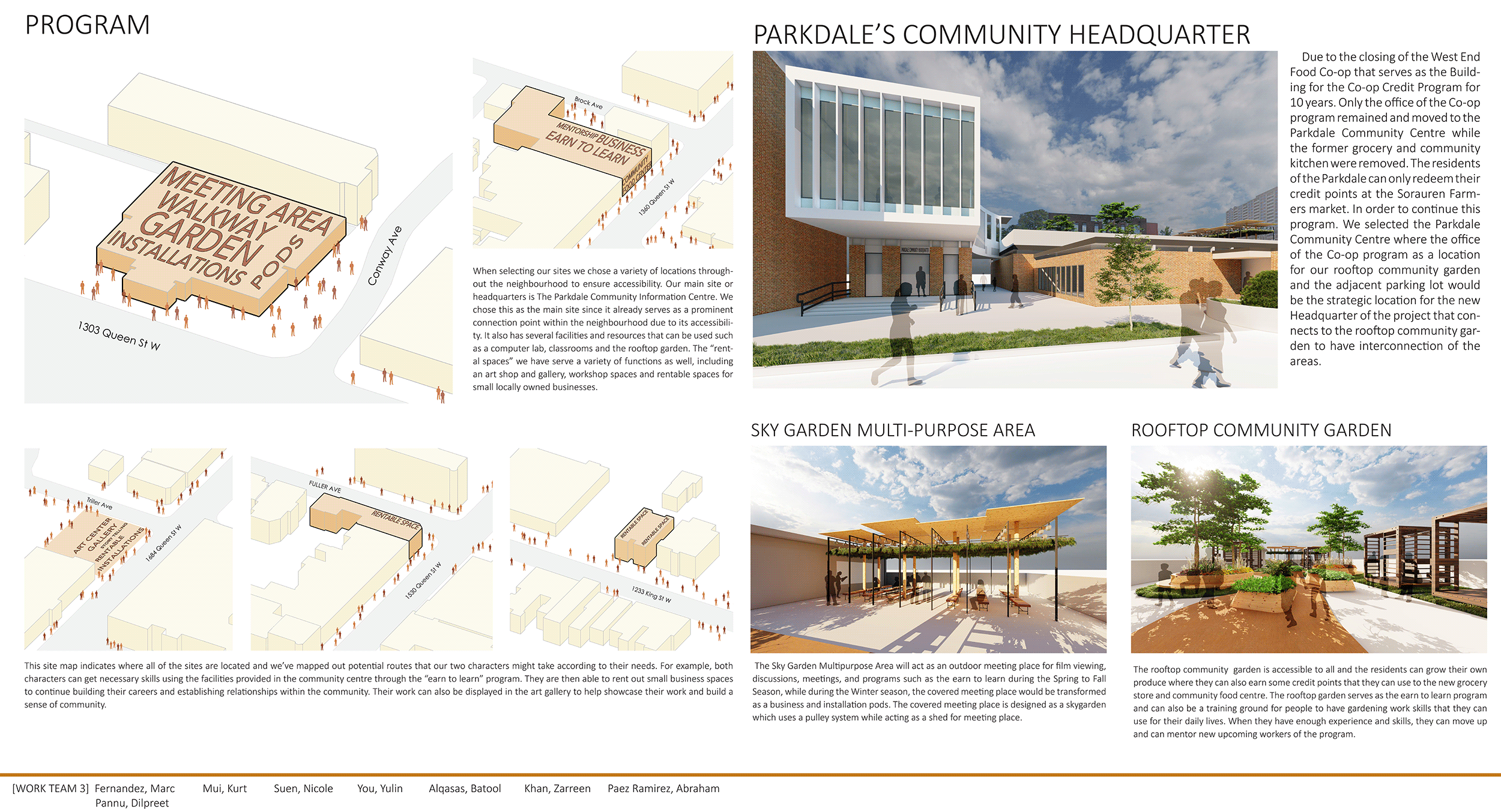
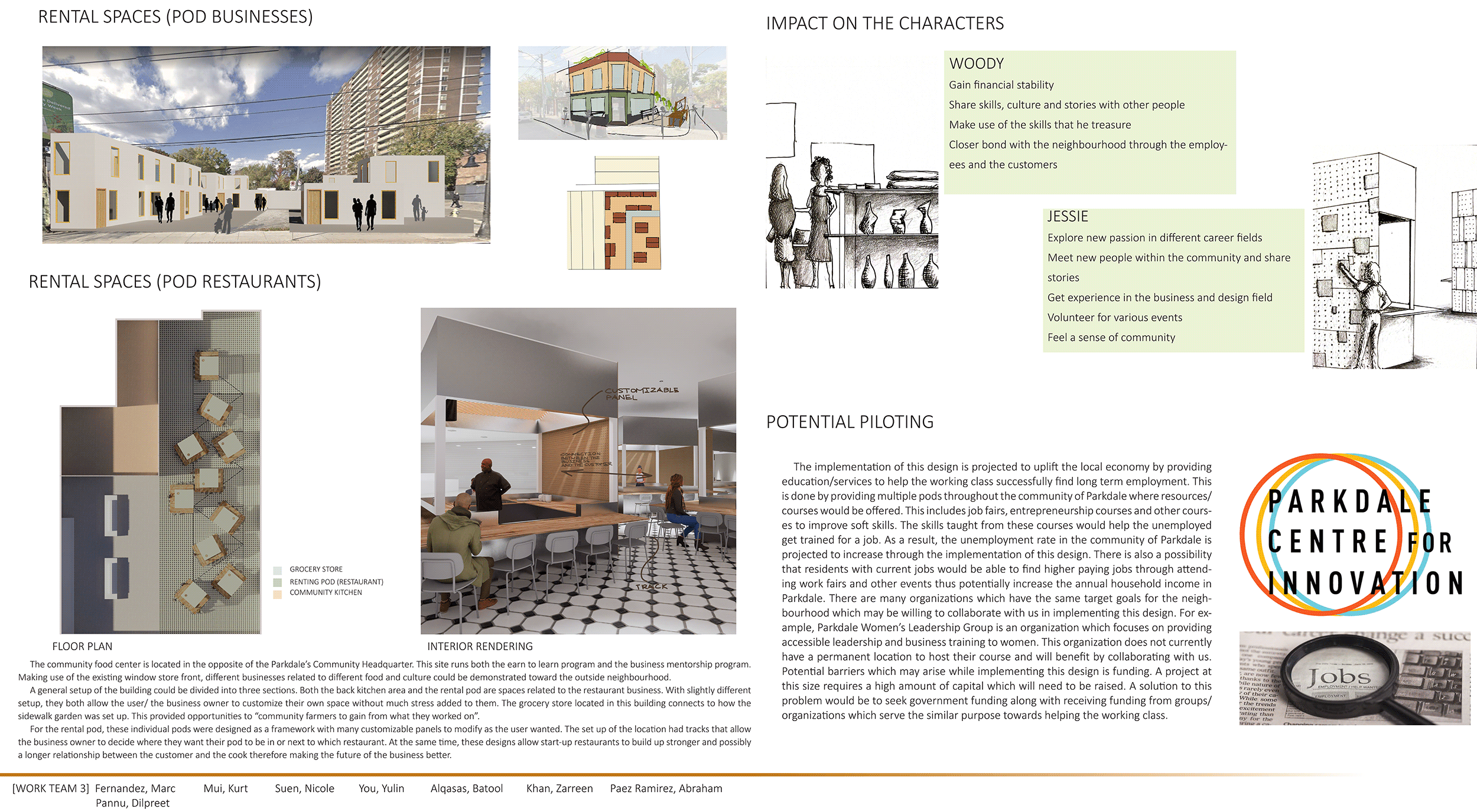
Jakos to Bedzie
![]()
![]()

